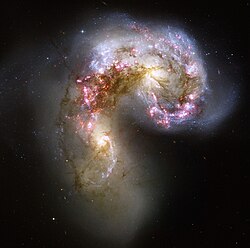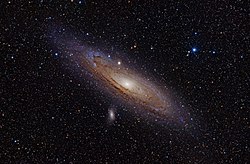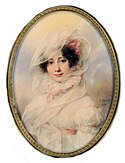Antennae 1997-34-a-full
This Hubble Space Telescope image provides a detailed look at a brilliant "fireworks show" at the center of a collision between two galaxies. Hubble has uncovered over 1,000 bright, young star clusters bursting to life as a result of the head-on wreck.
[Left] A ground-based telescopic view of the Antennae galaxies (known formally as NGC 4038/4039) - so named because a pair of long tails of luminous matter, formed by the gravitational tidal forces of their encounter, resembles an insect's antennae. The galaxies are located 63 million light-years away in the southern constellation Corvus.
[Right] The respective cores of the twin galaxies are the orange blobs, left and right of image center, crisscrossed by filaments of dark dust. A wide band of chaotic dust, called the overlap region, stretches between the cores of the two galaxies. The sweeping spiral- like patterns, traced by bright blue star clusters, shows the result of a firestorm of star birth activity which was triggered by the collision.
This natural-color image is a composite of four separately filtered images taken with the Wide Field Planetary Camera 2 (WFPC2), on January 20, 1996. Resolution is 15 light-years per pixel (picture element).
Credit: Brad Whitmore (STScI) and NASA| This file is in the public domain because it was created by NASA and ESA. NASA Hubble material (and ESA Hubble material prior to 2009) is copyright-free and may be freely used as in the public domain without fee, on the condition that only NASA, STScI, and/or ESA is credited as the source of the material. This license does not apply if ESA material created after 2008 or source material from other organizations is in use. The material was created for NASA by Space Telescope Science Institute under Contract NAS5-26555, or for ESA by the Hubble European Space Agency Information Centre. Copyright statement at hubblesite.org or 2008 copyright statement at spacetelescope.org. For material created by the European Space Agency on the spacetelescope.org site since 2009, use the {{ESA-Hubble}} tag. |
Relevante Bilder










































Relevante Artikel
Antennen-GalaxienDie Antennen-Galaxien bilden ein Paar stark miteinander wechselwirkender Galaxien im Sternbild Rabe südlich des Himmelsäquators. Das Paar besteht aus den beiden etwa 66 Millionen Lichtjahre entfernten Galaxien NGC 4038 und NGC 4039. .. weiterlesen
Wechselwirkende GalaxienWechselwirkende Galaxien sind Galaxien, die sich gegenseitig beeinflussen und damit ihre inneren Aktivitäten erhöhen. .. weiterlesen
GalaxieEine Galaxie ist eine durch Gravitation gebundene große Ansammlung von Sternen, Planetensystemen, Gasnebeln, Staubwolken, Dunkler Materie und sonstigen astronomischen Objekten mit einer Gesamtmasse von typischerweise 109 bis 1013 Sonnenmassen (M☉). Ihr Durchmesser kann mehrere hunderttausend Lichtjahre betragen. Während große Galaxien häufig die Struktur von Spiralen ausbilden, sind Zwerggalaxien zumeist irregulären Typs. Daneben existieren weitere Arten und Formen. Die Milchstraße, Heimatgalaxie unseres Sonnensystems, ist eine Balkenspirale von rund 1,5 Billionen M☉ mit etwa 250 Milliarden Sternen. Von der Erde aus lassen sich mit aktueller Technik mehr als 50 Milliarden Galaxien beobachten. Seit 2016 geht die Forschung davon aus, dass sich im beobachtbaren Universum ca. eine Billion Galaxien befinden. .. weiterlesen
7. FebruarDer 7. Februar ist der 38. Tag des gregorianischen Kalenders, somit bleiben 327 Tage bis zum Jahresende. .. weiterlesen

